Machine Learning-Driven Quantification of CO2 Plume Dynamics at Illinois Basin Decatur Project Sites Using Microseismic Data
Abstract
:1. Introduction
2. Materials and Methods
2.1. Illinois Basin Decatur Project Site
2.2. Subsurface Supercritical CO2 Transport and Storage Mechanisms
2.3. Importance of Natural Fractures and Baffles
2.4. Microseismic Monitoring
2.5. Machine Learning in Seismic Data Analysis
2.5.1. Data Collection and Visualization
- Origin Time: exact date and time of each microseismic event.
- Horizontal Difference: horizontal displacement in feet from a reference point.
- Depth Difference: vertical displacement in feet.
- Total Difference: combined horizontal and vertical displacements.
- Year/Mo. Category: categorizes events by year and month for temporal analysis.
2.5.2. Data Preprocessing and Feature Engineering
2.5.3. Data Visualization
2.5.4. Unsupervised Clustering Techniques
3. Results
3.1. Microseismic Monitoring of IBDP
3.2. Pulsed Neutron Logging (PNL) for CO2 Saturation Distribution
3.3. K-Means Clustering Techniques
3.4. DBSCAN Clustering Techniques
4. Discussion
5. Conclusions
Supplementary Materials
Author Contributions
Funding
Data Availability Statement
Conflicts of Interest
References
- IPCC. IPCC Sixth Assessment Report 2021. Available online: https://www.ipcc.ch/report/ar6/wg1/ (accessed on 23 May 2024).
- United Nations. United Nation Climate Change, 2015. Available online: https://unfccc.int/process-and-meetings/the-paris-agreement (accessed on 23 May 2024).
- Benson, S.M.; Cole, D.R. CO2 Sequestration in Deep Sedimentary Formations. Elements 2008, 4, 325–331. [Google Scholar] [CrossRef]
- Fathi, E.; Carr, T.R.; Adenan, M.F.; Panetta, B.; Kumar, A.; Carney, B.J. High-Quality Fracture Network Mapping Using High-Frequency Logging While Drilling (LWD) Data: MSEEL Case Study. Mach. Learn. Appl. 2022, 10, 100421. [Google Scholar] [CrossRef]
- IEA International Energy Agency. Greenhouses Gas R&D Program. 2007. Available online: http://www.ieagreen.org.uk/ (accessed on 29 May 2024).
- Finley, R.J. An Overview of the Illinois Basin-Decatur Project. Greenh. Gases Sci. Technol. 2014, 4, 571–579. [Google Scholar] [CrossRef]
- Freiburg, J.T.; Morse, D.G.; Leetaru, R.P.; Hoss, H.E.; Yan, Q. A Depositional and Diagenetic Characterization of the Mt. Simon Sandstone at the Illinois Basin-Decatur Project Carbon Capture and Storage Site, Decatur, Illinois, USA; Technical Report; Illinois State Geological Survey, Prairie Research Institute, University of Illinois: Champaign, Illinois, IL, USA, 2014; Circular No. 583. Available online: https://www.researchgate.net/publication/277890733_A_Depositional_and_Diagenetic_Characterization_of_the_Mt_Simon_Sandstone_at_the_Illinois_Basin_-_Decatur_Project_Carbon_Capture_and_Storage_Site_Decatur_Illinois_USA (accessed on 29 May 2024).
- Kaven, J.O.; Hickman, S.H.; McGarr, A.F.; Ellsworth, W.L. Surface Monitoring of Microseismicity at the Decatur, Illinois, CO2 Sequestration Demonstration Site. Seismol. Res. Lett. 2015, 86, 1096–1101. [Google Scholar] [CrossRef]
- Couëslana, M.L.; Butsch, R.; Will, R.; Locke II, R.A. Integrated Reservoir Monitoring at the Illinois Basin–Decatur Project. Energy Procedia 2014, 63, 2836–2847. [Google Scholar] [CrossRef]
- Mohsen, S.; Behrooz, A.; Roza, D. Artificial Intelligence, Machine Learning and Deep Learning in Advanced Robotics: A Review. Cogn. Robot. 2023, 3, 54–70. [Google Scholar]
- Zhou, R.; Huang, L.; Rutledge, J. Microseismic Event Location for Monitoring CO2 Injection Using Double-Difference Tomography. Lead. Edge 2010, 29, 208–214. [Google Scholar] [CrossRef]
- Adenan, M.F.; Fathi, E.; Carr, T.R.; Panetta, B. Advancing Subsurface Analysis: Integrating Computer Vision and Deep Learning for Near Real-Time Interpretation of Borehole Image Logs in the Illinois Basin Decatur Project. Interpretation 2024, 12, SB19–SB27. [Google Scholar] [CrossRef]
- Cavanagh, A.; Haszeldine, R.S. The Sleipner Storage Site: Capillary Flow Modeling of a Layered CO2 Plume Requires Fractured Shale Barriers within the Utsira Formation. Int. J. Greenh. Gas Control 2014, 21, 101–112. [Google Scholar] [CrossRef]
- Will, R.; Smith, V.; Leetaru, H.E.; Freiburg, J.T.; Lee, D.W. Microseismic Monitoring, Event Occurrence, and the Relationship to Subsurface Geology. Energy Procedia 2014, 63, 4424–4436. [Google Scholar] [CrossRef]
- Will, R.; El-Kaseeh, G.; Jaques, P.; Carney, M.; Greenberg, S.; Finley, R. Microseismic Data Acquisition, Processing, and Event Characterization at the Illinois Basin–Decatur Project. Int. J. Greenh. Gas Control 2016, 54, 404–420. [Google Scholar] [CrossRef]
- Williams-Stroud, S.; Stanek, F.; Dichiarante, A.; Langet, N.; Leetaru, H.; Eisner, L.; Greenberg, S. Integrating Induced Seismicity for Enhanced Subsurface Structural Interpretation at the Decatur, Illinois Sequestration Site. In Proceedings of the 16th International Conference on Greenhouse Gas Control Technologies, GHGT-16, Lyon, France, 23–27 October 2022. [Google Scholar]
- Cavanagh, A.J.; Marchant, B.P.; Williams, G.A. CO2 Storage Monitoring: Leakage Detection and Measurement in Subsurface Volumes from 3D Seismic Data at Sleipner. Energy Procedia 2014, 63, 4224–4239. [Google Scholar]
- Heath, J.E.; Bauer, S.J.; Broome, S.T.; Dewers, T.A.; Rodriguez, M.A. Petrologic and Petrophysical Evaluation of the Dallas Center Structure, Iowa, for Compressed Air Energy Storage in the Mount Simon Sandstone; Sandia National Lab. (SNL-NM): Albuquerque, NM, USA, 2013. [Google Scholar]
- Lahann, R.; Rupp, J.; Medina, C. An Evaluation of the Seal Capacity and CO2 Retention Properties of the Eau Claire Formation (Cambrian). Environ. Geosci. 2014, 21, 83–106. [Google Scholar] [CrossRef]
- Kruse, H.V. Heterogeneous Catalysis in Supercritical Media: 1. Carbon Dioxide. Chem. Eng. Technol. 2008, 31, 23–32. [Google Scholar] [CrossRef]
- Kang, S.M.; Fathi, E.; Ambrose, R.J.; Akkutlu, I.Y.; Sigal, R.F. Carbon Dioxide Storage Capacity of Organic-Rich Shales. SPE J. 2010, 16, 842–855. [Google Scholar] [CrossRef]
- Birkholzer, J.T.; Zhou, Q.; Tsang, C.F. Large-Scale Impact of CO2 Storage in Deep Saline Aquifers: A Sensitivity Study on Pressure Response in Stratified Systems. Int. J. Greenh. Gas Control 2009, 3, 181–194. [Google Scholar] [CrossRef]
- Oldenburg, C.M.; Rinaldi, A.P. Buoyancy Effects on Upward Brine Displacement Caused by CO2 Injection. Transp. Porous Media 2011, 87, 525–540. [Google Scholar] [CrossRef]
- Verdon, J.P.; Kendall, J.-M.; Stork, A.L.; Chadwick, A.R.; White, D.J.; Bissell, R.C. Comparison of Geomechanical Deformation Induced by Hydraulic Fracturing and CO2 Injection: A Case Study from the Weyburn CO2 Storage Project. Proc. Natl. Acad. Sci. USA 2013, 110, E2762–E2771. [Google Scholar] [CrossRef]
- Verdon, J.P. Microseismic Monitoring and Geomechanical Modeling of CO2 Storage in Subsurface Reservoirs. Ph.D. Thesis, University of Bristol, Bristol, UK, 2011. Available online: https://www1.gly.bris.ac.uk/~gljpv/PDFS/JamesVerdonThesis.pdf (accessed on 10 June 2024).
- Cheng, Y.; Liu, W.; Xu, T.; Zhang, Y.; Zhang, X.; Xing, Y.; Feng, B.; Xia, Y. Seismicity Induced by Geological CO2 Storage: A Review. Earth-Sci. Rev. 2023, 239, 104369. [Google Scholar] [CrossRef]
- Fathi, E.; Takbiri-Borujeni, A.; Belyadi, F.; Adenan, M.F. Simultaneous Well Spacing and Completion Optimization Using an Automated Machine Learning Approach: A Case Study of the Marcellus Shale Reservoir, Northeastern United States. Pet. Geosci. 2024, 30, petgeo2023-077. [Google Scholar] [CrossRef]
- Pham, V.V.; Fathi, E.; Belyadi, F. New Hybrid Approach for Developing Automated Machine Learning Workflows: A Real Case Application in Evaluation of Marcellus Shale Gas Production. Fuels 2021, 2, 286–303. [Google Scholar] [CrossRef]
- Lashari, S.Z.; Takbiri-Borujeni, A.; Fathi, E.; Sun, T.; Rahmani, R.; Khazaeli, M. Drilling Performance Monitoring and Optimization Using Artificial Intelligence Algorithms. J. Pet. Explor. Prod. Technol. 2019, 9, 2747–2756. [Google Scholar] [CrossRef]
- Ghahfarokhi, P.K.; Carr, T.; Bhattacharya, S.; Elliott, J.; Shahkarami, A.; Martin, K. A Fiber-Optic Assisted Multi-layer Perceptron Reservoir Production Modeling: A Machine Learning Approach in Prediction of Gas Production from the Marcellus Shale. In Proceedings of the Unconventional Resources Technology Conference, Houston, TX, USA, 23–24 July 2018. [Google Scholar]
- Ansari, A.; Fathi, E.; Belyadi, F.; Takbiri-Borujeni, A.; Belyadi, H. Data-Based Smart Model for Real Time Liquid Loading Diagnostics in Marcellus Shale via Machine Learning. In Proceedings of the SPE Canada Unconventional Resources Conference, Calgary, AB, Canada, 13–14 March 2018. D021S007R001. [Google Scholar]
- Ester, M.; Kriegel, H.-P.; Sander, J.; Xu, X. A Density-Based Algorithm for Discovering Clusters in Large Spatial Databases with Noise. In Proceedings of the 2nd International Conference on Knowledge Discovery and Data Mining (KDD-96), Portland, OR, USA, 2–4 August 1996; pp. 226–231. Available online: https://www.semanticscholar.org/paper/A-Density-Based-Algorithm-for-Discovering-Clusters-Ester-Kriegel/5c8fe9a0412a078e30eb7e5eeb0068655b673e86 (accessed on 14 June 2024).
- Moulavi, D.; Jaskowiak, P.A.; Campello, R.J.G.B.; Zimek, A.; Sander, J. Density-Based Clustering Validation. In Proceedings of the 2014 SIAM International Conference on Data Mining, Philadelphia, PA, USA, 24–26 April 2014. [Google Scholar]
- Greenberg, S.E. An Assessment of Geologic Carbon Sequestration Options in the Illinois Basin: Phase III; University of Illinois: Champaign, IL, USA, 2021. [Google Scholar]
- Fathi, E.; Arcentales, D.; Belyadi, F. Impacts of Different Operation Conditions and Geological Formation Characteristics on CO2 Sequestration in Citronelle Dome, Alabama. Energies 2023, 16, 3191. [Google Scholar] [CrossRef]


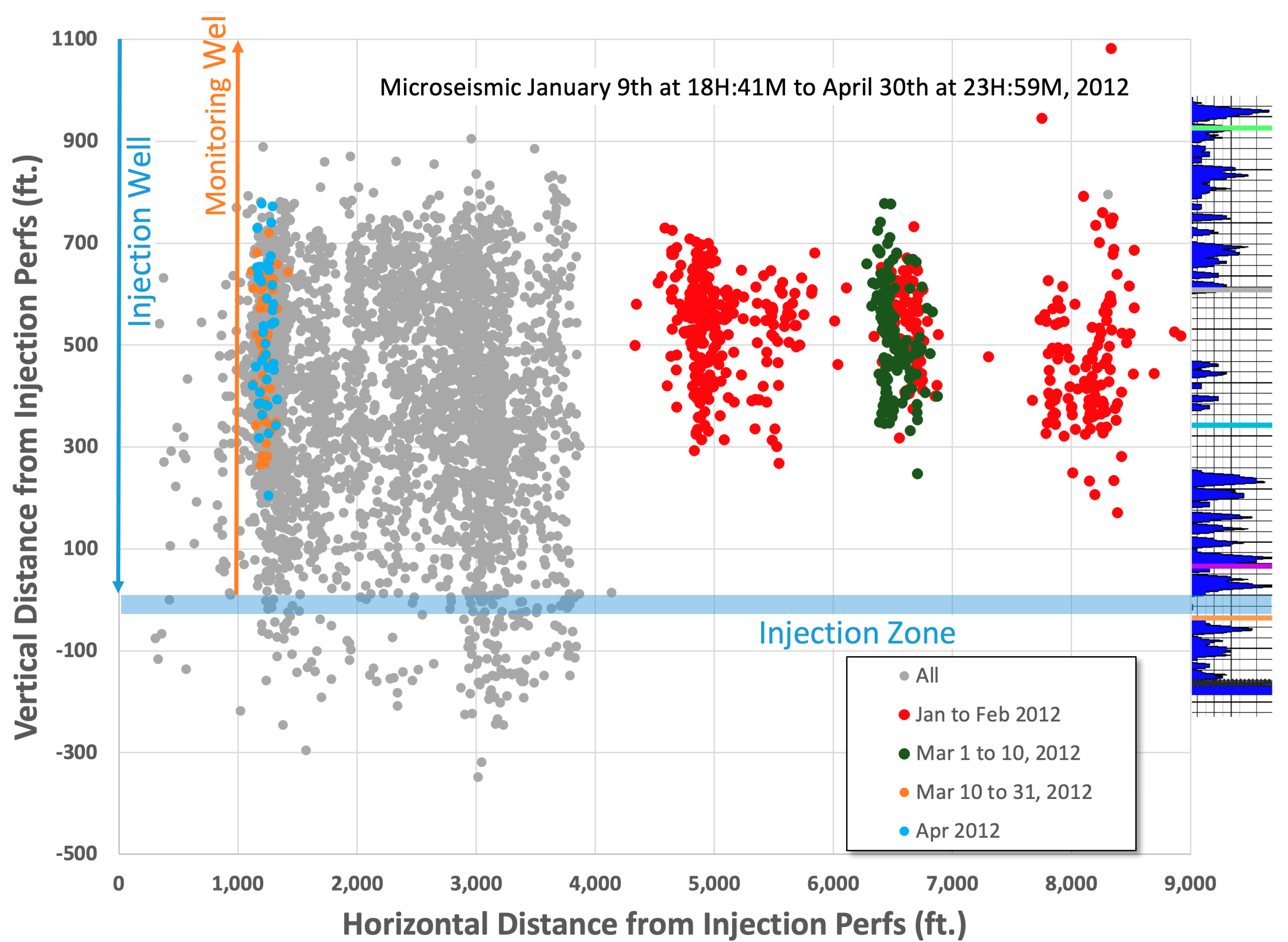

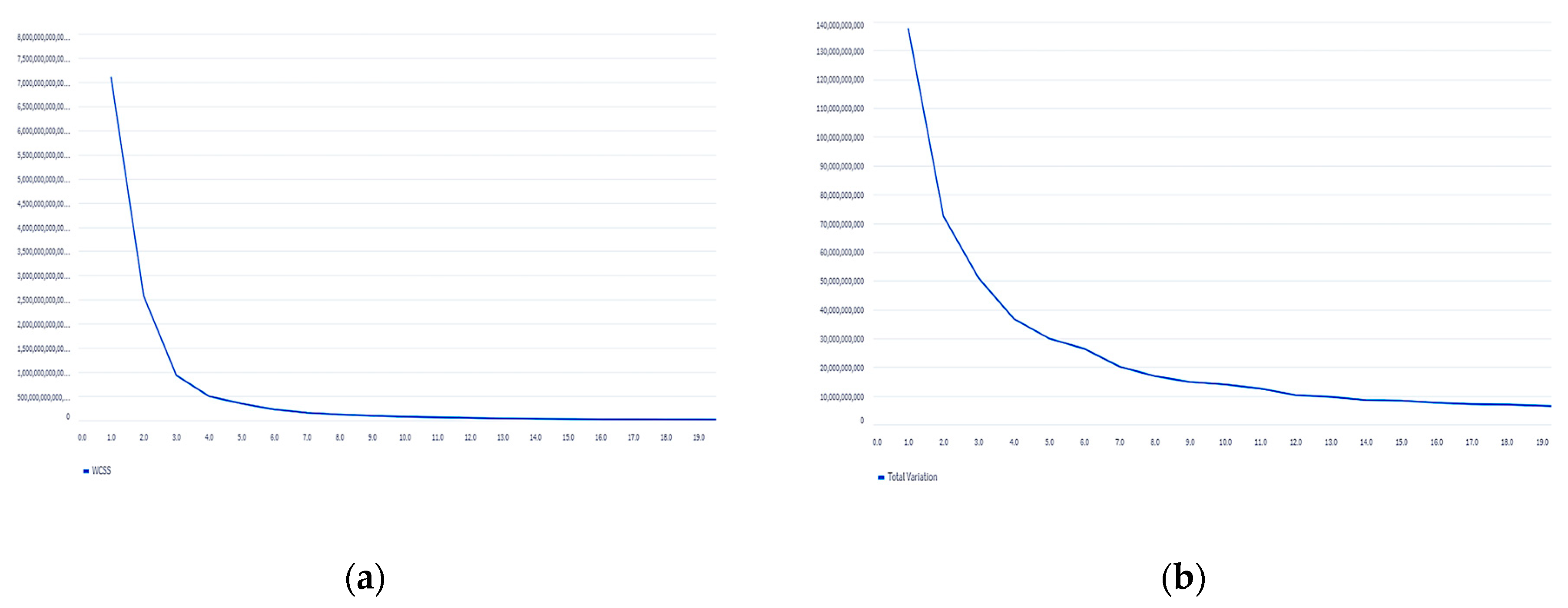
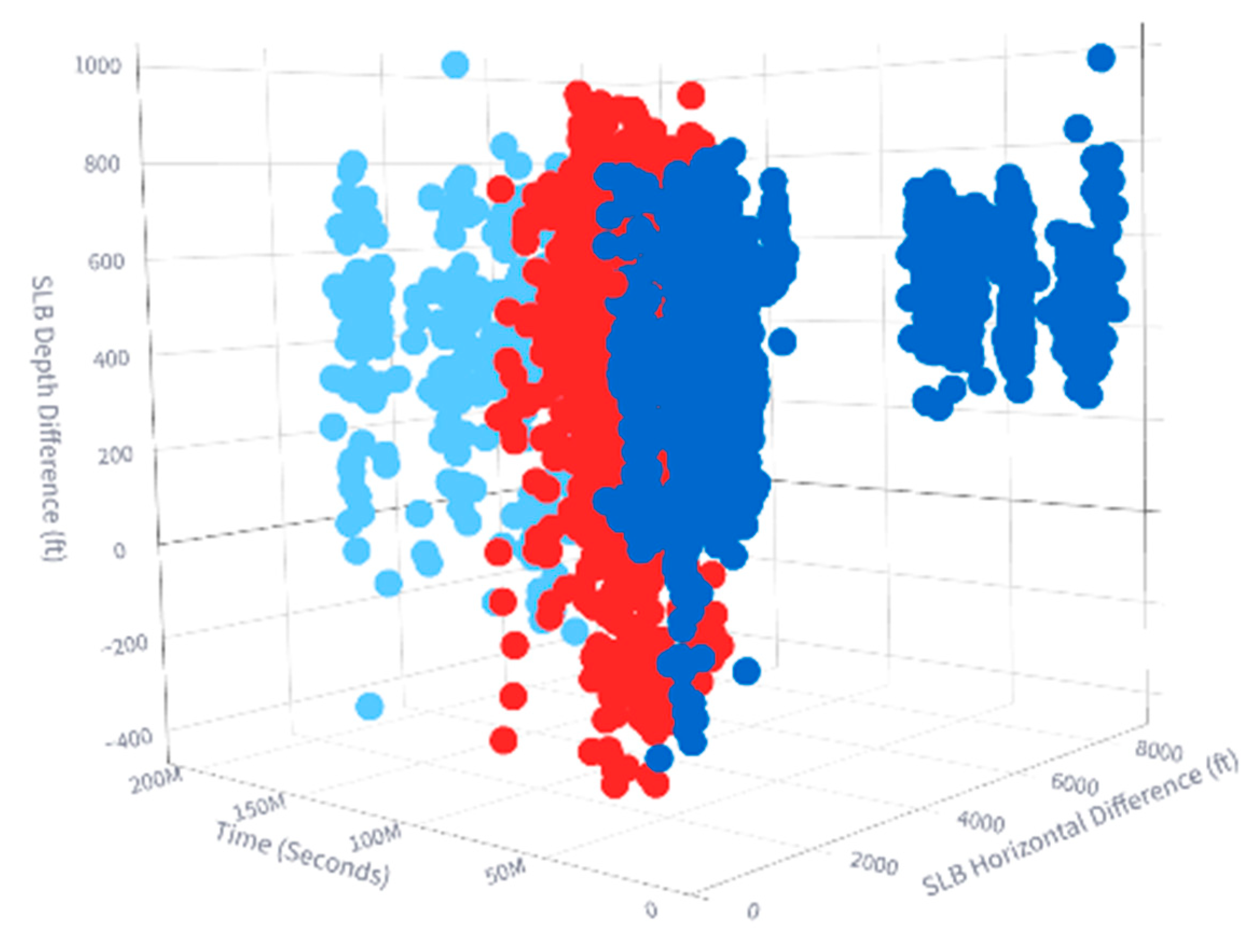

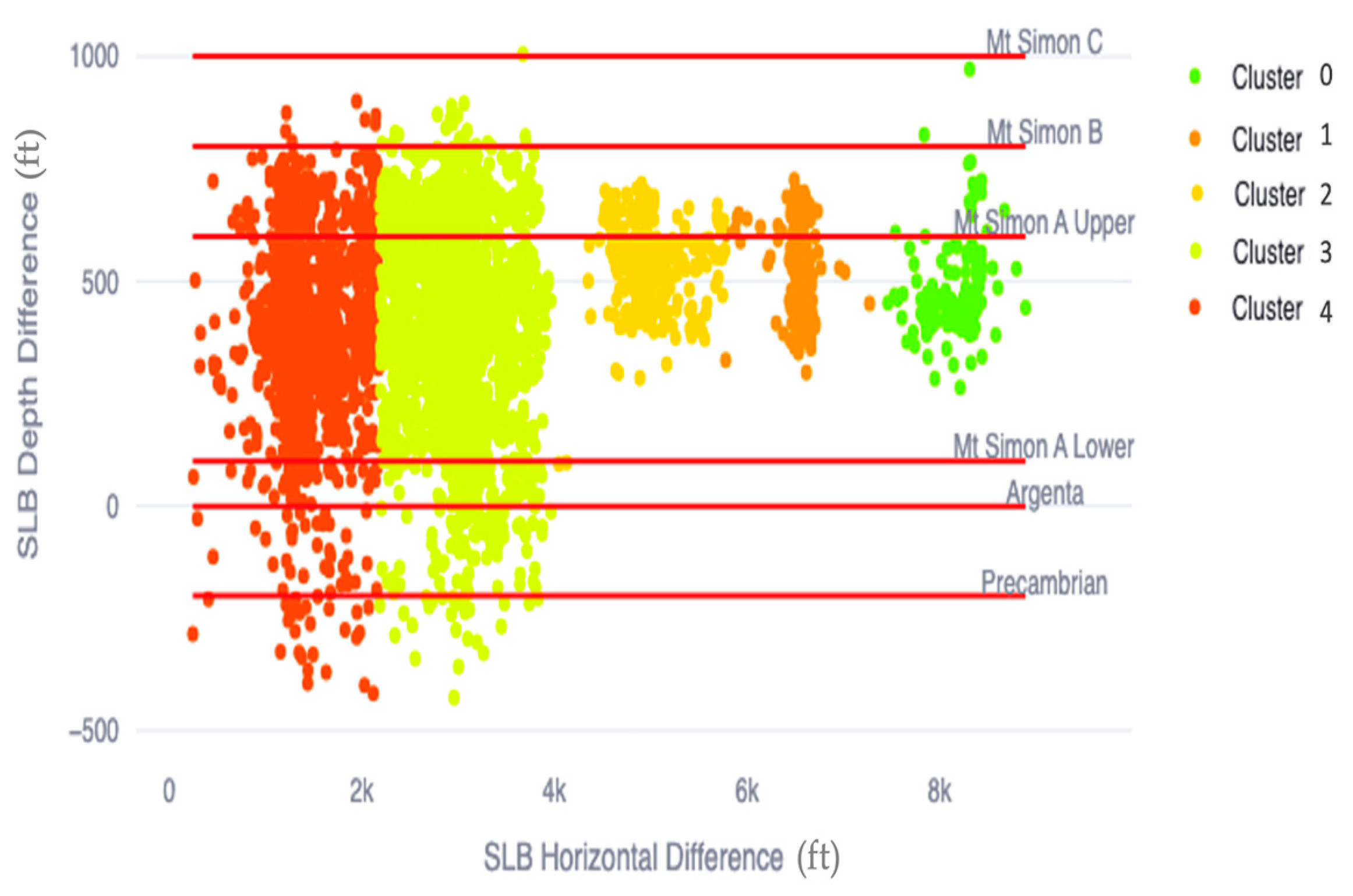

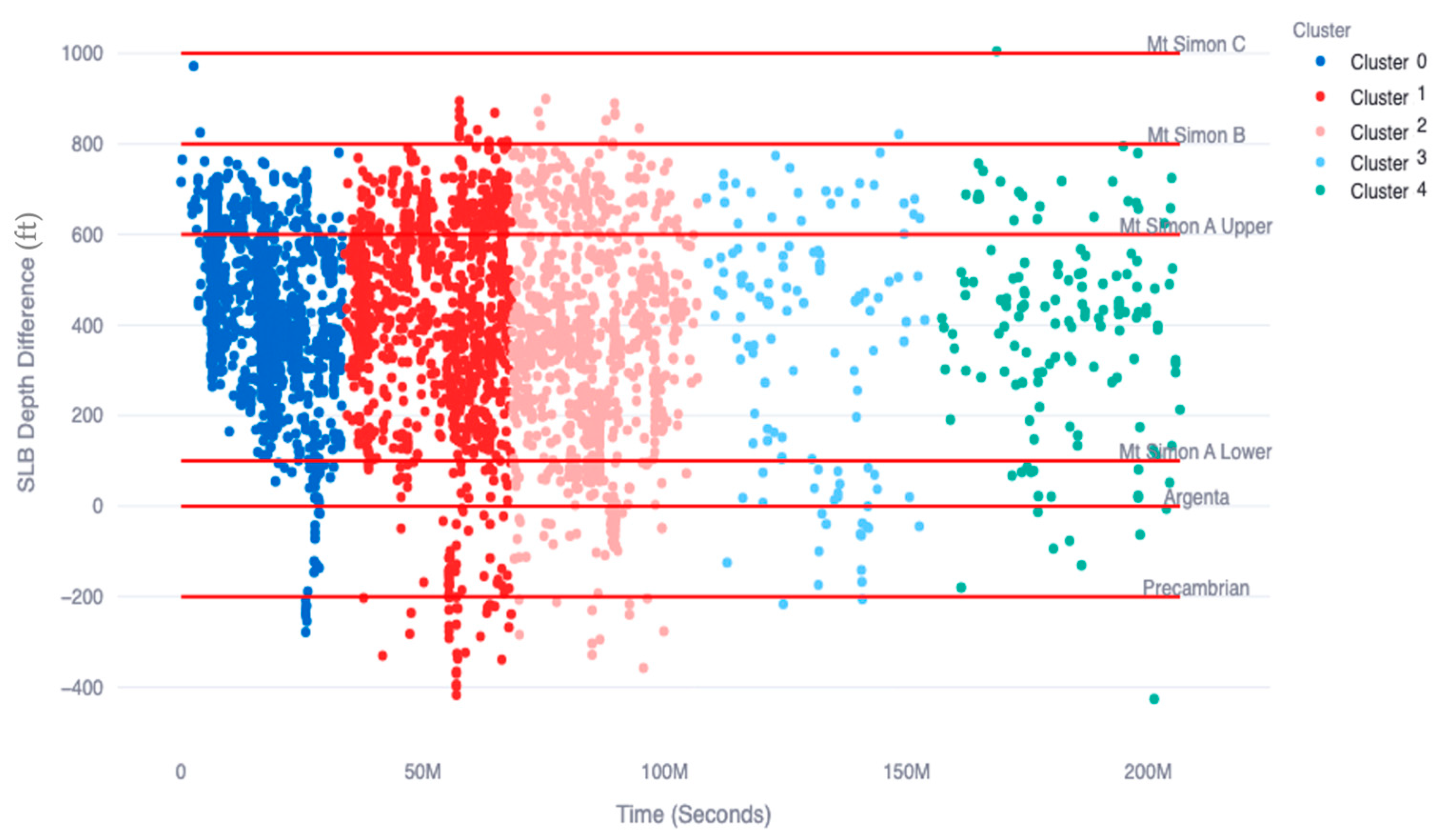

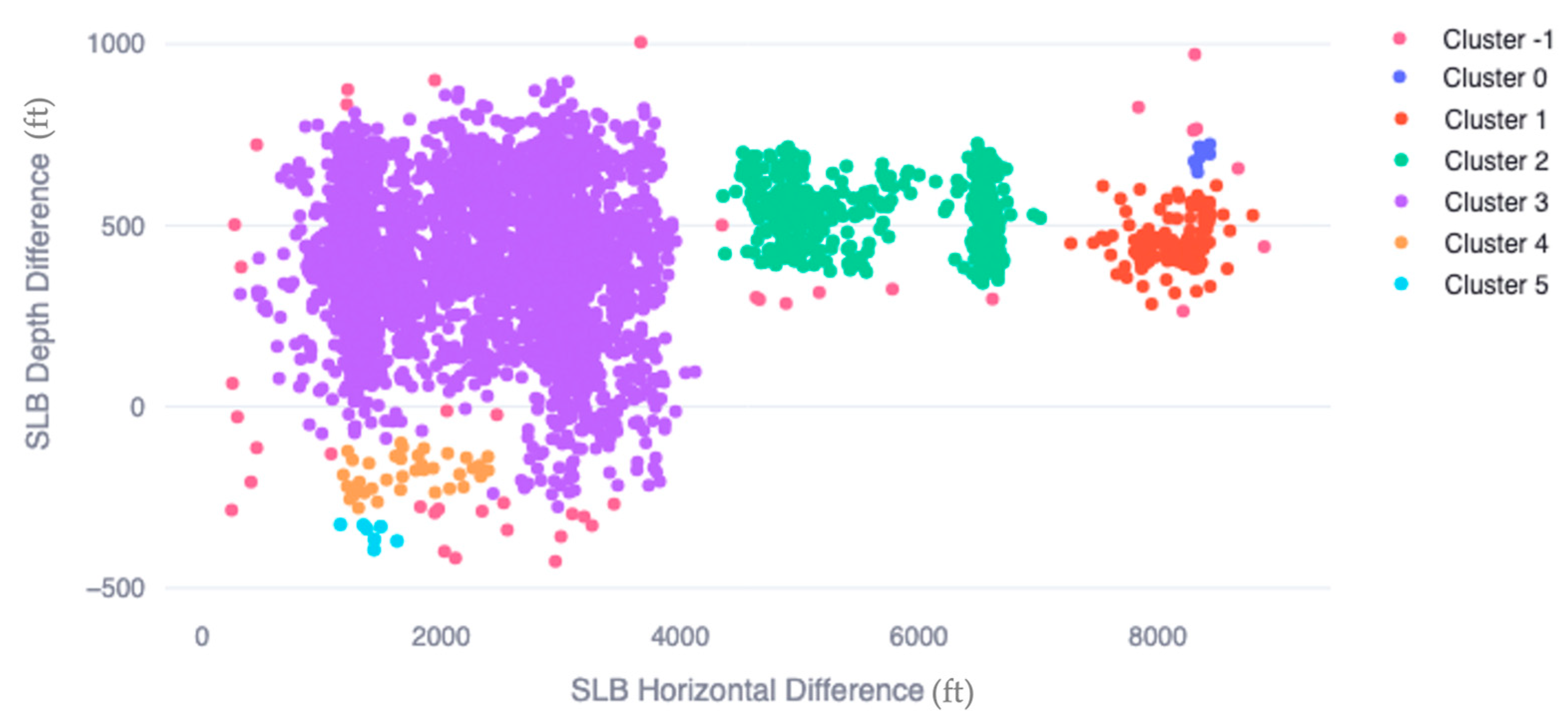
| Number of Clusters | Silhouette Score | Davies–Bouldin Index |
|---|---|---|
| 3 | 0.683 | 0.427 |
| 5 | 0.623 | 0.473 |
| Number of Clusters | Silhouette Score | Davies–Bouldin Index |
|---|---|---|
| 3 | 0.623 | 0.464 |
| 5 | 0.651 | 0.355 |
| Data 2D Subsets | Silhouette Score | Davies–Bouldin Index |
|---|---|---|
| SLB Depth Difference vs SLB Horizontal Difference | 0.651 | 0.355 |
| Time vs SLB Horizontal Difference | 0.638 | 0.461 |
| SLB Depth Difference vs Time | 0.638 | 0.461 |
| Epsilon | Number of Clusters | Silhouette Score |
|---|---|---|
| 0.2 | 7 | 0.338 |
Disclaimer/Publisher’s Note: The statements, opinions and data contained in all publications are solely those of the individual author(s) and contributor(s) and not of MDPI and/or the editor(s). MDPI and/or the editor(s) disclaim responsibility for any injury to people or property resulting from any ideas, methods, instructions or products referred to in the content. |
© 2024 by the authors. Licensee MDPI, Basel, Switzerland. This article is an open access article distributed under the terms and conditions of the Creative Commons Attribution (CC BY) license (https://creativecommons.org/licenses/by/4.0/).
Share and Cite
Iyegbekedo, I.; Fathi, E.; Carr, T.R.; Belyadi, F. Machine Learning-Driven Quantification of CO2 Plume Dynamics at Illinois Basin Decatur Project Sites Using Microseismic Data. Energies 2024, 17, 4421. https://doi.org/10.3390/en17174421
Iyegbekedo I, Fathi E, Carr TR, Belyadi F. Machine Learning-Driven Quantification of CO2 Plume Dynamics at Illinois Basin Decatur Project Sites Using Microseismic Data. Energies. 2024; 17(17):4421. https://doi.org/10.3390/en17174421
Chicago/Turabian StyleIyegbekedo, Ikponmwosa, Ebrahim Fathi, Timothy R. Carr, and Fatemeh Belyadi. 2024. "Machine Learning-Driven Quantification of CO2 Plume Dynamics at Illinois Basin Decatur Project Sites Using Microseismic Data" Energies 17, no. 17: 4421. https://doi.org/10.3390/en17174421
APA StyleIyegbekedo, I., Fathi, E., Carr, T. R., & Belyadi, F. (2024). Machine Learning-Driven Quantification of CO2 Plume Dynamics at Illinois Basin Decatur Project Sites Using Microseismic Data. Energies, 17(17), 4421. https://doi.org/10.3390/en17174421





